Items
Contributor is exactly
Jason Inskeep
-
 2022-05-23
2022-05-23Jason Inskeep Biography Sheet
This biography was created out of a self-directed project from the HST580 class. This biography will be linked to the submissions of the person mentioned in the document and title. -
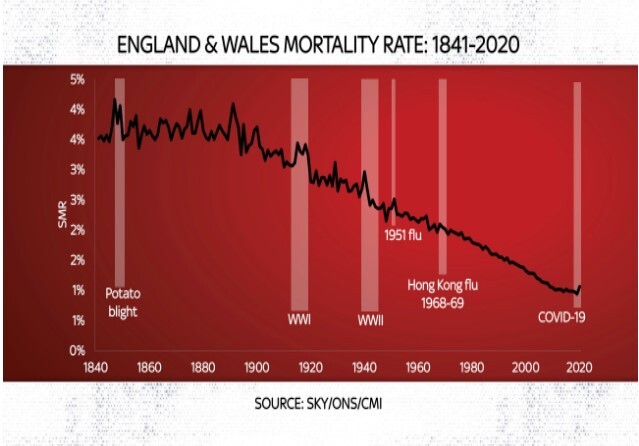 2021-03-01
2021-03-01Skeptic's flawed analysis of pandemics over a century using data that ignores population growth and globalization.
The attached image was used as evidence in an article for pandemic skeptics to make a "realistic risk assessment" of their danger during the COVID-19 pandemic in an article originally published in March 2021. The image utilizes only the mortality rate of England and Wales over the last century to visually "show" that COVID-19 is just a "blip" on the map. They are seemingly hinting through an image that this pandemic is fake news compared to world wars or influenza, using data to propagandize skepticism. What is misleading about this data is that they are using numbers of today against nearly one hundred years ago and are not contextualizing the numbers at all. At first glance one can see the overall mortality rate is going down. Of course, this is due to improved science, sanitization, water, and medicine over this time period. We must not also forget that this rate has gone down because the number of people in England and Wales, as in all life on our Earth, has increased. Like all math problems, the larger the denominator the small the rate. For example, if 100 people died out of a population of 1,000, the mortality rate is 10% (100/1000x100). But, if 100 people died in a population of 10,000, the mortality rate is only 1 percent (100/10000x100). Trying to compare numbers in a situation where the world population is much different and globalized, is not an equal comparison. I believe this is misleading persuasive propaganda that skeptics used to make COVID look like not a big deal. However, the risk factors have much more to do with your age, location, health history, interaction with other people, and how your surrounding areas respond to a pandemic, none of which is contextualized in this vague graph. -
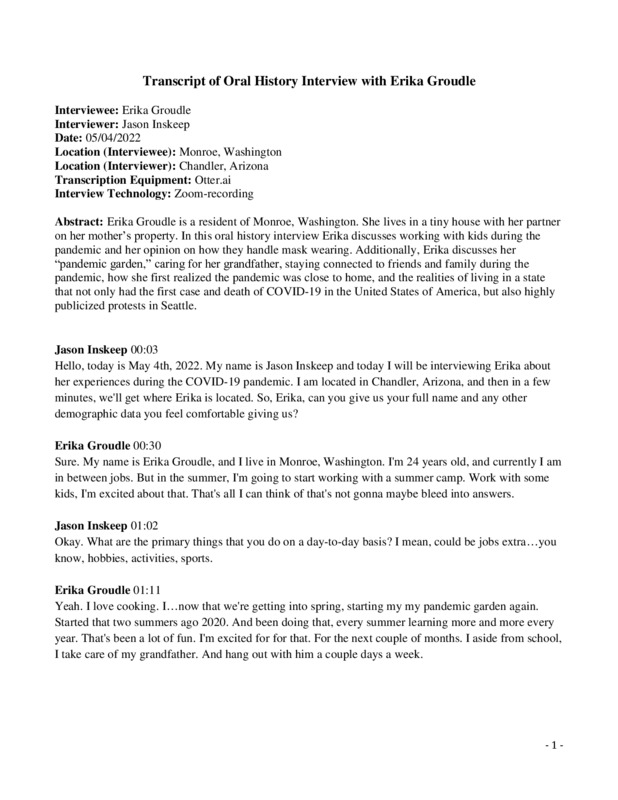 2022-05-04
2022-05-04Erika Groudle Oral History, 2022/05/04
Erika Groudle is a resident of Monroe, Washington. She lives in a tiny house with her partner on her mother’s property. In this oral history interview Erika discusses working with kids during the pandemic and her opinion on how they handle mask wearing. Additionally, Erika discusses her “pandemic garden,” caring for her grandfather, staying connected to friends and family during the pandemic, how she first realized the pandemic was close to home, and the realities of living in a state that not only had the first case and death of COVID-19 in the United States of America, but also highly publicized protests in Seattle. Interviewer: Jason Inskeep Interviewee: Erika Groudle -
 2021-04-08
2021-04-08Did COVID doubters' perspective get lumped in with deniers?
I believe we all know someone during the worst days of the pandemic who doubted that it was as serious as it really was. Perhaps they willingly discussed their perspective, reluctantly talked about it if pressed, or just did not even want to talk about it. I am not talking about the people seen in the attached article that were out protesting masks or vaccines, pushing conspiracy theories on 5G and Bill Gates' love of vaccines. I am thinking of the people we work with, are friends with, or very likely are in our families that just really just wanted life back to normal and did not think the global reaction was justified. A casual search of the internet for the perspectives of COVID doubters, or those who thought that the reaction to the pandemic was over-the-top, immediately sends you to articles and stories about the horrors and idiocy of the COVID deniers who pushed crazy theories about world dominance. Wouldn't it be nice to understand how the middle ground of the pandemic felt, lived, and reacted to the reality of the pandemic, if at all? We owe it to future generations to not only highlight the worst in the deniers, as seen in the attached article, but to also illustrate the everyday people who just were not sure who to believe, fake news or science. One thing is for sure, it is not fair to lump everyone in the middle into the far right. I would like to hear the stories of people who doubtfully lived in the pandemic, their trials, frustrations, and tribulations and if they had any change of heart or ideals. Their perspective will give a further understanding of the sociological impact of the pandemic. -
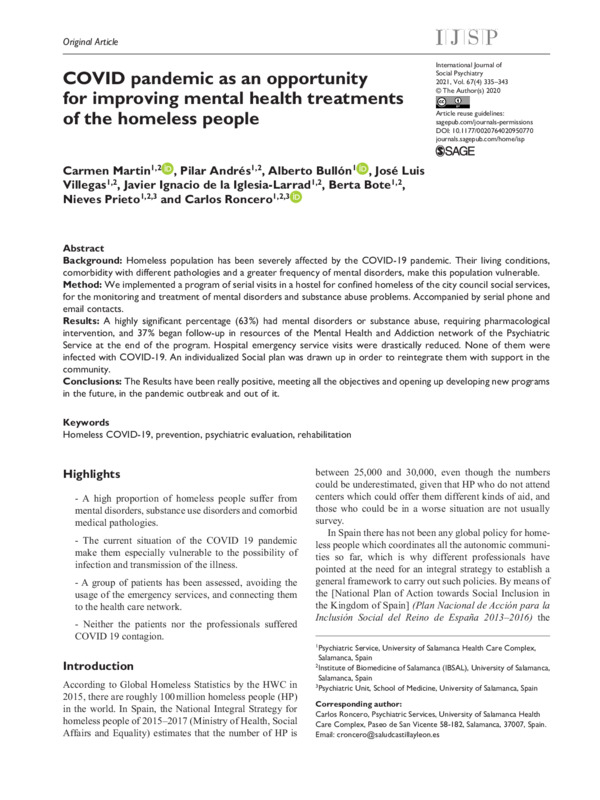 2021-06-27
2021-06-27Pandemic lockdown gives a new opportunity towards homeless mental health. A study from Spain
While the COVID-19 pandemic has drastically altered mental health, see https://covid-19archive.org/s/archive/page/mental-health, I hope that there could be benefits to mental health as COVID rates around the world drop. It is now more convenient than ever to partake in counseling services from the comfort of your room, especially if you have social anxiety or pandemic anxiety. Unfortunately, statistics are not out as of March 2022 that demonstrate that mental health is improving with waning COVID rates, instead counselors, psychiatrists, and psychologists seem busier than ever. While telehealth meetings are convenient, wait times and schedules are full of the backlog of people whose mental health was affected by the pandemic. I wanted to find an example of a positive outcome on mental health through COVID's global sweep, especially as COVID wanes. Attached is an example of a study in Spain that focused on a group of homeless in Spain that were in lockdown. "More than 60% of them presented mental disorders and within 8 weeks they were visited in person 2–3 times...Finally, 51.8% were linked to social and health care services and 37% to mental health resources, which can constitute a step forward in their reintegration and normalization." They argue that if it was not for COVID and these efforts, these homeless people may not have been diagnosed and helped. The paper concludes that this study is useful for the future because it shows how under immensely stressful situations, primary and secondary interventions worked. This can be repeated without a pandemic. While the pandemic was very stressful, it reaped some benefits such as a new focus on mental health, new methods of talking with trained professionals, and studied like this that show data of improving mental health in times of stress. -
2022-03-27
Sometimes I forget my aunt died of COVID-19.
Although my aunt was not a significant part of my life since about 2007, she was still family. During the midst of the large outbreak in the summer of 2020 my dad texted me that she was in the hospital, then was released, and then was found deceased in her home a few days later. At this time, it was hard to have a body “processed” quickly, for lack of better words, through morgues and funeral homes. Additionally, having a funeral service was not advised because of either lockdown, funeral homes limiting attendance, or these homes even not performing services. On top of that, many people would have been hesitant to attend. My dad and his siblings decided to not have a service. I have heard many other similar stories. Perhaps this became a pandemic funerary custom to some; life went on and no occasion was marked. Even though we were not super close, and I was not despondent, this would have been a way to process and mark a death for me. For others, a time to process grief. To summarize, she died of COVID-19. I could not visit her in the hospital, and we did not have a funeral service or a burial. I feel that because of the pandemic my family did not go through the traditions and customs that help people process and accept death. I am not sure how my parents and sister feel. I have mistakenly wondered what my aunt was up to, temporarily forgetting her death. Even though we weren't the closest I would have had a memory marker achieved through tradition and grieving/funerary customs that would have given others the peace needed. -
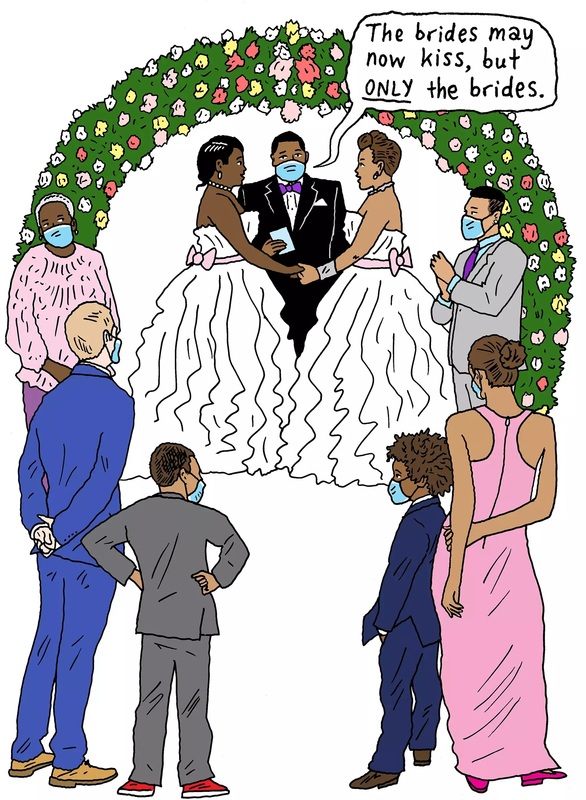 2022-03-27
2022-03-27Were masks and pandemic anxiety a useful distraction towards ideas that should not matter, but did (to many)?
Like everything having to do with public interactions during the COVID-19 pandemic, social distancing and lockdowns significantly impacted "traditional weddings." Gone were the days of large weddings, dancing around mask free and hugging the happy couple. If you search the internet, you will find a large amount of information on happy couples who had to cancel or alter their plans. Many of the #COVID BRIDES stories on this archive illustrate the extreme panic of changing plans and constant change, such as wearing masks in their pictures. The pandemic altering, delaying, or even preventing weddings has impacted society's mental health and perhaps future cultural traditions in weddings. This archive has a collection on mental health, https://covid-19archive.org/s/archive/page/mental-health, which demonstrates how hard this pandemic has been on many people. The effects on mental health shows how weddings are a popular and important tradition in American society. The ceremony is a way to share your love before others, blend families and friends, and move from a "single person" to a team. When I say wedding, I mean the customs and celebration within the ceremony, not the genders of the couple. Gay marriage has not been legal throughout America long, only since 2013. The anxiety and stress of two years of delayed/cancelled weddings during a pandemic pale in comparison to the longstanding social pressure for LGBTQ people not to marry, on top of previous legality issues. There is still a large group of Americans that have the opinion that it is "evil" or a sin. I have seen and heard in person, movies, or television disparaging remarks on the idea of two men or two women getting married and/or kissing. I wanted to highlight this picture from TIME magazine as I hope it demonstrates that masks made people freak out. The idea that the officiant and the people were so distracted and concerned about the two brides either not wearing masks or being the only two kissing while not wearing masks----rather than not being male/female made me smile. I hope some of the pain, anxiety, and discomfort of the pandemic was turned into positivity by distracting people from the meaningless idea of couple's gender and that some LGBTQ opponents realized there are bigger problems in the world. -
 2022-03-20
2022-03-20Jason Inskeep, A Day in the Life of the COVID-19 Pandemic
A Day in the Life of the COVID-19 Pandemic, 2022 edition: After two years of living in this pandemic, Dr. Kole de Peralta from Arizona State University, has asked me to ponder on how my day-to-day life has changed (or not changed) because of the pandemic. There are a handful of routine activities in a normal day that I will examine: dropping my daughter at school, conversations with my wife about her work, yard work, grocery shopping, my own workday, and extended family interactions. Several of these subjects I have reflected on before, but others I have not put much thought into. Dropping my daughter off at school: Ignoring the early pandemic stage, i.e., online school for my daughter, for the last year my daughter has been attending middle school in person. Before the pandemic this was a simple task of getting into the car, driving, and dropping her off. However, the process has evolved into making sure that she has a mask or two on her, as until recently masks were mandatory. Multiple times we have had to run back home or to the store due to forgetting a mask. This had added another layer to our morning routine. However, I must note, she is a stellar example of selfless health consciousness. Even when she does not have to wear a mask, she is typically the one that will, even reminding me. Interestingly, masks are no longer mandatory in her school, yet she still wears them and complains about the kids who do not. While a daily routine was altered for our family, she also appears to group kids into masks wearers and non-mask wearers. Conversations with my wife about her work: My wife is a 3rd grade teacher. Pre-pandemic she checked in occasionally with how her day was going, how the kids were behaving, or just to check on our dogs. Until last week, masks were still required at her school. As she works at a school for the deaf, this caused many communication and behavior issues. Most of our conversations have become about how difficult it is to sign to the children in her class without the necessary component of facial emotion for inflection or the equivalent of intonation. Or she will also discuss how the kids act about the masks. Ironically, when they removed the mask requirement last week, she then texted me that she felt vulnerable, even though she knew it was better for her and the kids’ communication. While this obviously affected my wife more than me, the pandemic has changed how families talk about work and school. Rather than, “how was your day at school,” questions changed to “did the kids wear masks and did anyone get isolated?” Yard work: In late 2019 I developed a horrible sinus infection that caused eye issues and facial pain. I discovered later this was likely from trimming poisonous Oleander bushes without a mask on. I also routinely mowed the yard with no mask. I often had some form of face or noise pain before that, which looking back sounds idiotic. I likely would have worn a mask if I had one sitting around, but it always became an issue of realizing I needed one and lazily just wanting the work completed. However, as an “essential worker,” my company supplied my family with an endless supply of masks. Today, now that masks are readily available, I find myself wearing them during yard work and my sinus issues have all but been eradicated. Grocery Shopping: My family used to shop as a crew, now my wife and I take turns because of the pandemic and continue two years later. This has changed a weekly routine, but I am ok with it. Here is a link to a previous archive item that included this discussion, https://covid-19archive.org/s/archive/item/46478. My workday: A typical workday for me as a shift technician worker, pre-pandemic, would begin and end with a pass down meeting with our night shift. The meetings took place in one room with approximately ten people, in a central location. We would then cram as many people as would fit into golf carts and separate to four different factories for our workday. Additionally, we would sit at desks, perform routine maintenance, and assist each other throughout the day, all within cross proximity. After the pandemic, started people began getting sick and getting each other sick. I work in the semi-conductor industry and there was a parallel surge in demand for chips. Beyond just our health, it was apparent that if people were not separated, it was possible that our mega-site could negatively affect the global chip supply chain and my employer’s bottom line. Thus, jobs like mine were made “essential” and safety rules were vastly improved. Other “non-essential” people began to work from home to make the site safer for essential work. Even today, we meet in four different control rooms rather that all in one room, with ¼ the people, wear masks unless eating, cannot ride more than one person in front and one person in the back of golf carts, and must perform complex maintenance tasks six feet apart and if this is not possible wear supplied air masks. While management may remove some of the safety regulations soon, things have become more complex at my job and manufacturing industries because of COVID-19. I also have to walk up to one to two miles a day due to golf cart rules, which is probably not a bad thing. Extended family interactions: The pandemic is slowly wanning. Rather than stopping by my parent’s house or simply all agreeing to have dinner as a family for a birthday on a certain day, as it was before the pandemic, things have changed. My family spends a fair amount of time to discuss how everyone is feeling and if we should cancel before we meet if someone is sick. Thus, all our plans are much more complicated, and we find ourselves meeting up as a family less out of caution. COVID-19 has altered the type and frequency of my extended family’s interactions. The COVID-19 pandemic has changed my days. However, it seems to me that I, and those around me, always adjust to situations that at first seem so stressful. Humans are highly adaptable, even to extremely spontaneous and stressful situations. Even more than we give credit to ourselves for. This exercise shows some things I had not even thought about, because I did not have a choice and just adjusted. Which is surprising because I am known as the biggest worrier! -
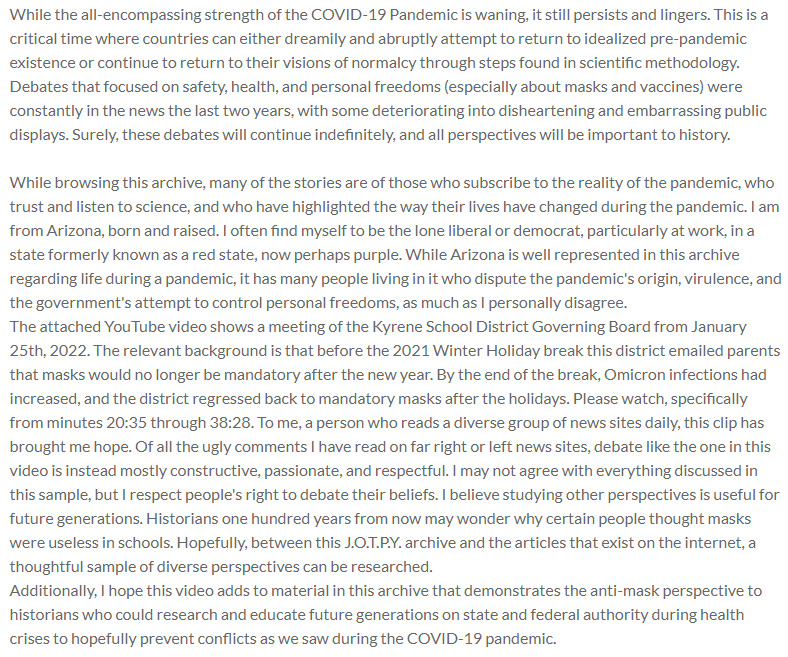 2022-03-15
2022-03-15Passionate and (mostly) respectful recent debate in the waning pandemic
While the all-encompassing strength of the COVID-19 Pandemic is waning, it still persists and lingers. This is a critical time where countries can either dreamily and abruptly attempt to return to idealized pre-pandemic existence or continue to return to their visions of normalcy through steps found in scientific methodology. Debates that focused on safety, health, and personal freedoms (especially about masks and vaccines) were constantly in the news the last two years, with some deteriorating into disheartening and embarrassing public displays. Surely, these debates will continue indefinitely, and all perspectives will be important to history. While browsing this archive, many of the stories are of those who subscribe to the reality of the pandemic, who trust and listen to science, and who have highlighted the way their lives have changed during the pandemic. I am from Arizona, born and raised. I often find myself to be the lone liberal or democrat, particularly at work, in a state formerly known as a red state, now perhaps purple. While Arizona is well represented in this archive regarding life during a pandemic, it has many people living in it who dispute the pandemic's origin, virulence, and the government's attempt to control personal freedoms, as much as I personally disagree. The attached YouTube video shows a meeting of the Kyrene School District Governing Board from January 25th, 2022. The relevant background is that before the 2021 Winter Holiday break this district emailed parents that masks would no longer be mandatory after the new year. By the end of the break, Omicron infections had increased, and the district regressed back to mandatory masks after the holidays. Please watch, specifically from minutes 20:35 through 38:28. To me, a person who reads a diverse group of news sites daily, this clip has brought me hope. Of all the ugly comments I have read on far right or left news sites, debate like the one in this video is instead mostly constructive, passionate, and respectful. I may not agree with everything discussed in this sample, but I respect people's right to debate their beliefs. I believe studying other perspectives is useful for future generations. Historians one hundred years from now may wonder why certain people thought masks were useless in schools. Hopefully, between this J.O.T.P.Y. archive and the articles that exist on the internet, a thoughtful sample of diverse perspectives can be researched. Additionally, I hope this video adds to material in this archive that demonstrates the anti-mask perspective to historians who could research and educate future generations on state and federal authority during health crises to hopefully prevent conflicts as we saw during the COVID-19 pandemic. This video is owned and uploaded by the Kyrene School District to YouTube. -
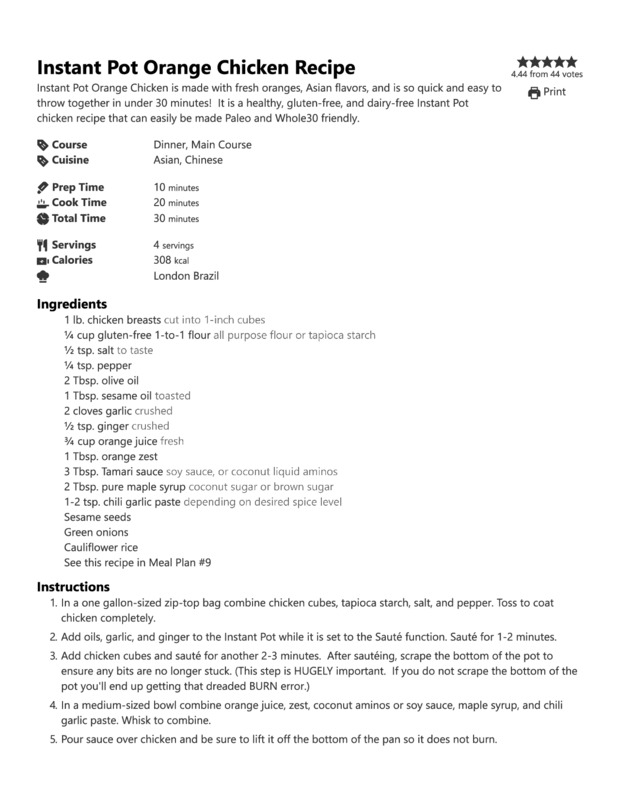 2020-04-09
2020-04-09Pandemic Dinner of Gluten-Free Orange Chicken is a Sensory Reminder of Evolving Grocery Shopping and the Effect on My Mental Health
Pre-Pandemic, my small family of three went shopping altogether at our local Frys Grocery every Sunday. As the type of person that lives inside their head and has difficulty multi-tasking when distracted, this was usually an overwhelming experience. It involved avoiding people parked sideways in aisles, answering questions from my wife and daughter (somehow usually at the same time), and being interrupted by loud intercoms. To me it was sensorial overload every week of my hearing and vision to the point where I wanted to leave. When the pandemic really started up in April of 2020 my wife and I decided that my daughter should stay home and we would take turns shopping every week individually to decrease the chances of affecting the employees, the other customers, and ourselves. Along with this was my increased effort to come up with meals and recipes on my "turn." The recipe attached, gluten-free orange chicken from https://www.evolvingtable.com, reminds me of this interesting evolution in shopping that still takes place, as it is my turn to shop today. While my wife looks upon the idea of shopping individually as a loss and misses it...I am able to shop without being overwhelmed. Between less customers in the store (due to ordering online and pick up), the store progressing to using handheld radios, and being by myself, I can really focus and no longer am stressed and overwhelmed to the point where I just want to leave. Every time I make this recipe and taste the delicious orange flavor and smell that hot sesame oil that I had never used before the pandemic, it reminds me of how a stressful pandemic has strangely (and selfishly) made one recurring weekday of my life less stressful. -
 2020-10-13
2020-10-13The end of quiet time in the home.
I am very lucky. I have a job that allows me to work 12-hour shifts, which means I have three or four days off a week. I used to have the time while my daughter was at school and my wife (a teacher) was at work to relax or work on my master's classes. These classes take concentration and time to read and write, and noise is very distracting to me. I should also mention that we purposely bought a small house, less than 1300 sq. feet. Suddenly in March, 2020, my world (at the risk of sounding selfish) was changed. My wife was teaching from home, juggling rooms back and forth with me for computer usage etc., while my daughter was asking for help with school. The voice mail attached is a memory I have of my comfortable little environment changing. This particular voicemail surely caused stress and anxiety to the parents of 16,000 students in one district. Even today listening to it feels ominous. Ironically, today I dropped my daughter off for the first time at in-person school, and I was sad to see her go. *Voicemail sound file from my child's school district announcing school closures.
